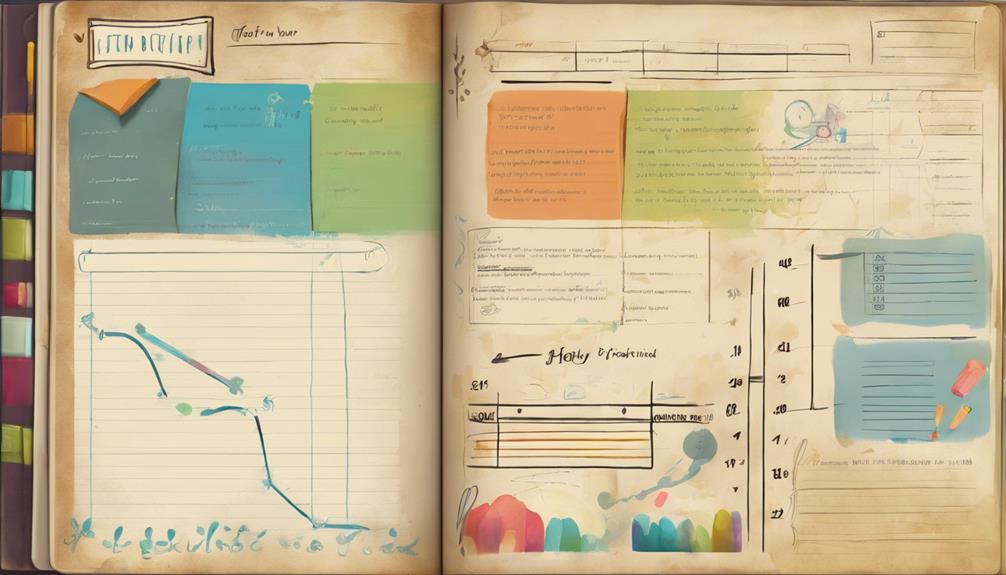Enhance your progress and elevate motivation by keeping a goal journal! Define your aspirations clearly, enhance self-awareness, and track your achievements effectively. Reflecting on your journey fosters growth and empowers you to make informed decisions. Through journaling, you strengthen your accountability, cultivate a growth mindset, and practice gratitude. Embrace setbacks with self-compassion and stay focused on your goals. Immerse yourself in the transformative power of goal journaling to access extraordinary success and fulfillment.
Key Takeaways
- Enhances focus, motivation, and accountability.
- Fosters self-awareness and personal growth.
- Provides insights into thoughts and emotions.
- Tracks progress, achievements, and development.
- Cultivates resilience, positivity, and growth mindset.
Setting Clear Goals

Start by jotting down your clear goals in a goal journal to define your aspirations and track your progress effectively. Setting goals in a goal journal provides you with a roadmap to follow, guiding you towards your desired outcomes. By clearly outlining your objectives, you give yourself a sense of direction and purpose, making it easier to stay focused and motivated.
When you set goals in your goal journal, you enhance your accountability. Having your goals written down holds you responsible for taking the necessary actions to achieve them. This accountability factor can boost your motivation and drive to work consistently towards your goals.
Moreover, goal setting in a journal allows you to measure your progress over time. You can reflect on how far you've come and what adjustments may be needed to stay on track. This reflection fosters self-awareness and personal growth, empowering you to make informed decisions and prioritize tasks effectively.
Enhancing Self-Awareness

Enhancing self-awareness through goal journaling involves reflecting on personal strengths and weaknesses, fostering a deeper understanding of oneself. By actively engaging in this practice, you can gain valuable insights into your thoughts, emotions, and behaviors, ultimately leading to personal growth and development.
Recognize Patterns:
Tracking progress in your goal journal allows you to identify recurring behaviors or habits that may be helping or hindering your success.
Clarify Values:
Setting specific goals in your journal can help you clarify what truly matters to you and what you aspire to achieve.
Discover Motivations:
Regularly journaling about your goals enables you to explore your inner motivations, providing a clearer understanding of why you pursue certain objectives.
Improve Emotional Intelligence:
Reflecting on past achievements and setbacks in your goal journal enhances self-awareness and emotional intelligence, empowering you to navigate challenges effectively and manage emotions more skillfully.
Through the simple act of keeping a goal journal, you can deepen your self-awareness and set off on a journey of self-discovery.
Fostering Reflection

Fostering reflection in your goal journal involves actively engaging in introspection to evaluate your progress and adjust your strategies accordingly. By taking the time to reflect on your goals, you can identify your strengths, weaknesses, and areas for improvement.
Journaling facilitates introspection, allowing you to assess how well your current strategies are working and make necessary adjustments. Recording your thoughts and feelings related to your goals provides a deeper understanding of your motivations and the obstacles you may be facing.
Regular reflection in your goal journal fosters mindfulness, helping you become more aware of patterns and gain insights into effective goal-setting strategies. This mindfulness can lead to increased accountability as you track your actions, decisions, and outcomes over time.
Embracing reflection in your goal journal not only enhances your self-awareness but also empowers you to make informed decisions and progress towards achieving your goals effectively.
Tracking Progress and Achievements

Tracking your progress and achievements in a goal journal is a powerful way to stay motivated and focused on your goals. By journaling regularly, you can effectively keep track of your goals and celebrate your accomplishments along the way.
Here are some key benefits of tracking your progress and achievements in a goal journal:
- Reflect on Daily Achievements: Documenting your daily successes and challenges allows for reflection on your journey towards achieving your goals.
- Stay Motivated: Tracking progress in your goal journal provides motivation to keep pushing forward, even when faced with obstacles.
- Visualize Growth: Recording your achievements in a journal enables you to visually see how far you have come and track your development over time.
- Tangible Reminder: Your goal journal serves as a tangible reminder of the hard work you have put in to reach your milestones, reinforcing your commitment to your goals.
Keeping a journal not only helps you track progress but also reinforces your dedication to achieving your goals.
Practicing Self-Compassion

Practicing self-compassion in goal journaling involves showing kindness and understanding towards yourself, especially during setbacks and challenges. By incorporating self-compassion into your goal journaling routine, you can foster a positive mindset that's essential for staying motivated and resilient in the face of obstacles.
Research indicates that self-compassion leads to greater overall well-being, as it encourages self-forgiveness and reduces negative self-talk, ultimately promoting a healthier approach to setting and achieving goals.
When you practice self-compassion in your goal journal, you allow yourself the space to acknowledge mistakes without harsh self-judgment, enabling you to learn and grow from your experiences. Embracing self-compassion in goal journaling not only helps you bounce back from failures with grace but also fosters a sense of self-acceptance that's vital for long-term success in reaching your goals.
Cultivating Gratitude

When you cultivate gratitude in your goal journal, you're actively acknowledging and appreciating the progress you've made towards your goals.
By reflecting on your achievements and milestones, you can enhance feelings of gratitude and satisfaction in your journey.
Practicing gratitude in your journal can lead to improved overall well-being by shifting your focus to the positive aspects of your life.
Gratitude Practice
Cultivating gratitude in your goal journal can greatly enhance your overall well-being and mindset. By incorporating gratitude practice in your goal journaling, you can experience a range of benefits:
- Boost Motivation: Reflecting on what you're grateful for in your journey can ignite motivation and drive to keep progressing.
- Enhance Confidence: Acknowledging your achievements and expressing gratitude for them can boost your self-confidence.
- Improve Mental Well-being: Studies have shown that practicing gratitude can lead to improved mental well-being and increased levels of happiness.
- Foster Self-awareness: Cultivating gratitude in your goal journal can enhance your self-awareness, helping you understand your values and priorities better.
Through the simple act of integrating gratitude into your goal journaling routine, you can positively impact your mindset, motivation, and overall outlook on life.
Thankful Reflections
Embracing thankful reflections in your goal journal can greatly elevate your sense of gratitude and well-being. By engaging in gratitude journaling, you can focus on the positive aspects of your life, leading to enhanced positivity and overall mental health.
Regularly recording moments of gratitude in your journal has been shown to reduce stress, increase happiness levels, and promote a sense of fulfillment. Cultivating gratitude through journaling not only boosts resilience but also improves your outlook on life.
Practicing gratitude allows you to appreciate the present moment and find joy in everyday experiences. Taking the time to reflect on what you're thankful for and jotting it down in your goal journal can have profound effects on your overall well-being.
Achieving Mindfulness

By reflecting on your progress and setbacks in a goal journal, you enhance mindfulness and focus on the present moment. Journaling can help you in various ways, such as:
- Promoting Self-Awareness: Writing down your thoughts and experiences allows you to become more conscious of your emotions and behaviors.
- Increasing Focus: Daily journaling keeps you grounded and attentive to your goals, helping you concentrate on what truly matters.
- Reducing Stress: Mindfulness achieved through goal journaling can decrease stress and anxiety levels, leading to better mental well-being.
- Enhancing Clarity: Regularly practicing mindfulness in your goal journal can bring clarity and purpose to your actions and decisions.
Through the simple act of jotting down your goals and reflecting on your journey, you can cultivate mindfulness, which, in turn, contributes to a more fulfilling and intentional life.
Cultivating a Growth Mindset

To cultivate a growth mindset through goal journaling, you must embrace challenges and setbacks as opportunities for personal development. By believing in your ability to improve through dedication and hard work, goal journaling becomes a powerful tool for progress.
Setting specific goals, reflecting on your journey, and seeing failures as stepping stones to success all contribute to fostering a positive attitude towards challenges.
Growth Mindset Importance
Cultivating a growth mindset through goal journaling helps you approach challenges as opportunities for growth and learning. By embracing this mindset, you can enhance your personal growth journey significantly.
Here are some key points to highlight the importance of a growth mindset in goal journaling:
- Resilience: Individuals with a growth mindset are more resilient in the face of setbacks, viewing them as opportunities to learn and improve.
- Motivation: A growth mindset fosters intrinsic motivation, driving you to persistently work towards your goals despite obstacles.
- Belief in Improvement: By focusing on effort and strategies, a growth mindset instills a belief in your ability to continuously improve and succeed.
- Positive Adaptation: Goal journaling can assist in shifting from a fixed mindset to a growth mindset, encouraging reflection and adaptation for continuous development.
Embracing a growth mindset through goal journaling empowers you to navigate challenges with a positive attitude, ultimately leading to greater personal development and goal achievement.
Mindset for Progress
Embracing a growth mindset involves confronting challenges head-on, persisting through setbacks, and recognizing effort as the pathway to mastery. To cultivate this mindset for progress, it's crucial to journal every day. By writing every day, you can track your journey, reflect on your experiences, and identify areas for growth.
Set your goals in your journal, break them down into manageable steps, and celebrate your progress along the way. This practice not only helps you stay focused but also enhances your mental health by promoting self-awareness and mindfulness.
Committing to a growth mindset through consistent journaling empowers you to face obstacles with resilience and view them as opportunities for learning and development. This shift in perspective can lead to increased motivation, self-improvement, and overall well-being. Remember, the way you perceive challenges and setbacks greatly influences your ability to achieve success and fulfillment.
Developing Positive Attitude
Develop a positive attitude by incorporating goal journaling into your daily routine to foster a growth mindset. Journal writing allows you to reflect on setbacks and challenges, leading to a more positive outlook on your journey towards achieving your goals.
Here are four key ways goal journaling can help you cultivate a positive attitude:
- Embracing Growth: By focusing on learning and development in your goal journal, you shift towards viewing obstacles as opportunities for personal growth.
- Resilience Building: Keeping a goal journal helps you develop resilience by encouraging you to persevere through challenges and setbacks.
- Shift in Perspective: Through goal journaling, you can change your mindset from fixed abilities to continuous self-improvement, fostering a more positive attitude towards your progress.
- Learning from Setbacks: Reflecting on setbacks in your journal enables you to extract valuable lessons and insights, turning obstacles into stepping stones towards success.
Incorporating goal journaling into your routine can significantly impact your attitude and mindset, empowering you to approach challenges with a positive and growth-oriented mindset.
Promoting Accountability

Keeping a goal journal enhances accountability by visually documenting progress and reinforcing commitment to plans. When you track your goals in a journal, you create a tangible record of your journey towards success. By writing down your goals and actions, you hold yourself accountable for taking the necessary steps to achieve them.
Regularly reviewing your journal entries allows you to reflect on your progress, identify areas for improvement, and stay focused on your objectives. Setting deadlines and milestones in your goal journal instills a sense of responsibility and urgency, pushing you to work diligently towards your goals.
Additionally, sharing your journal entries with a mentor or accountability partner can provide external accountability and support, keeping you motivated and on track. Embracing the accountability that a goal journal offers can greatly increase your chances of success in achieving your aspirations.
Frequently Asked Questions
What Are the Five Benefits of Keeping a Journal?
You gain clarity on aspirations and progress, set and achieve goals effectively, promote mindfulness and positive habits, stay accountable and committed, leading to a sense of accomplishment and boosted self-confidence through keeping a journal.
What Goals Journaling Accomplish?
Journaling goals aids in organization, focus, and progress tracking. It enhances self-awareness, motivates action, and fosters commitment. By setting clear objectives, documenting progress, and reflecting on achievements, you can cultivate a sense of purpose and accomplishment. The benefits of goal journaling extend beyond personal development, as it also helps in prioritizing tasks and managing time effectively. Moreover, it serves as a valuable tool for self-improvement, as it encourages reflection and growth. The benefits of goal journaling are numerous, making it a valuable practice for anyone looking to achieve their aspirations and make positive changes in their lives.
What Is Most Likely a Benefit of Keeping a Journal?
Keeping a journal allows you to organize thoughts, spark creativity, and process emotions. It offers a safe space to express yourself freely, improve cognitive function, and reduce stress. Embrace the power of journaling!
Should I Journal My Goals?
You should definitely journal your goals. It helps you stay organized, focused, and motivated. Plus, it gives you a clear roadmap to success. Remember, "A goal without a plan is just a wish." Start journaling today!
Conclusion
So, as you can see, keeping a goal journal is like having a personal cheerleader by your side, cheering you on every step of the way.
So grab a pen, open a fresh page, and start jotting down those dreams and ambitions.
You never know what amazing things you can achieve when you have a little journal on your side, whispering words of encouragement in your ear.
Remember, your goals are within reach – all you have to do is write them down and watch them come to life.









